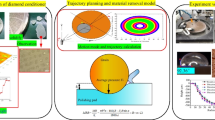Temperature control to stabilize the microscale contact surface between the pad and wafer, especially to prevent pad surface degradation, plays an important role in chemical mechanical polishing (CMP) processing of sub- 50-nm devices. In this work, we investigated the phenomenon of pad surface hardening for various process temperatures and developed an effective method to minimize changes of the mechanical properties of the pad surface using diamond conditioner. The pad hardening characteristics were measured based on the force–distance (F-D) curve obtained by atomic force microscopy (AFM), and thermogravimetric analysis (TGA). F-D curve data showed that the increase of the elastic modulus with pad usage time at high process temperature was ~1.5 times higher than at low process temperature. Also, TGA of a used polishing pad revealed a link between the endothermic peak intensity at 600°C and pad surface hardening. To prevent surface glazing or hardening throughout the lifetime of a pad at high process temperature, the optimum diamond size was investigated. Pad wear was investigated for various diamond conditioners with diamond grit size ranging from 100 μm to 270 μm. The results of pad surface analysis using scanning electron microscopy (SEM) and three-dimensional optical profiling showed that the 210 μm grit size was best for removing deformed layers, with the pad surface remaining consistent during the lifetime of the pad as verified by TGA and the F-D curve. The results of pad surface analysis are important for the design of conditioners that can produce pads with stable dynamic mechanical properties and prolonged lifetime at high process temperature.
Similar content being viewed by others
References
F.B. Kaufman, D.B. Thompson, R.E. Broadie, M.A. Jaso, and M.B. Small, J. Electrochem. Soc. 138, 3460 (1991).
W.J. Patrick, W.L. Guthrie, C.L. Standley, and P.M. Schiable, J. Electrochem. Soc. 138, 1778 (1991).
A. Jindal, S. Hegde, and S.V. Babu, Electrochem. Solid St. 5, 48 (2002).
A. Jindal, S. Hegde, and S.V. Babu, J. Electrochem. Soc. 150, 314 (2003).
T. Katoh, H. Kang, U. Paik, and J. Park, Jpn. J. Appl. Phys. 42, 1150 (2003).
N.H. Kim, Y. Seo, and W. Lee, Microelectron. Eng. 83, 362 (2006).
H.J. Kim, H.Y. Kim, H.D. Jeong, E.S. Lee, and Y.J. Shin, J. Mater. Process. Tech. 130, 334 (2002).
W. Li, D.W. Shin, M. Tomozawa, and S.P. Murarka, Thin Solid Films 270, 601 (1995).
Z. Li, L. Borucki, I. Koshiyama, and A. Philipossian, J. Electrochem. Soc. 151, 482 (2004).
T. Wang and T. Hseieh, Polym. Degrad. Stabil. 55, 95 (1997).
J. Ferguson and Z. Petrovic, Eur. Polym. J. 12, 177 (1976).
T.C. Chang, W.S. Shen, Y.S. Chid, and S.Y. Ho, Polym. Degrad. Stabil. 49, 353 (1995).
Y. Zhao and L. Chang, Wear 252, 220 (2002).
B. Cappella and G. Dietler, Surf. Sci. Rep. 34, 1 (1999).
Y.S. Liao, M.Y. Tsai, J.C. Sung, and Y.L. Pai, Key Eng. Mater. 329, 151 (2007).
T. Yu, C.C. Yu, and M. Orlowski, Int. Electron. Dev. Meeting 1993, 865 (1993).
G. Ahmadiz and X. Xia, J. Electrochem. Soc. 148, 99 (2001).
A.C. Fischer-Cripps, Introduction to Contact Mechanics (New York: Springer-Verleg, 2000).
Author information
Authors and Affiliations
Corresponding author
Rights and permissions
About this article
Cite this article
Yang, J.C., Oh, D.W., Kim, H.J. et al. Investigation on Surface Hardening of Polyurethane Pads During Chemical Mechanical Polishing (CMP). J. Electron. Mater. 39, 338–346 (2010). https://doi.org/10.1007/s11664-009-1064-0
Received:
Accepted:
Published:
Issue Date:
DOI: https://doi.org/10.1007/s11664-009-1064-0



